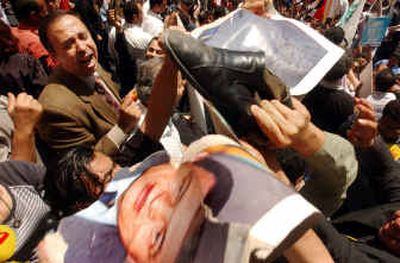State agents beat protesters, marring referendum in Egypt

CAIRO, Egypt – Plainclothes government agents beat protesters Wednesday, then watched as President Hosni Mubarak’s supporters punched other demonstrators in scattered violence that marred a referendum the 24-year ruler has called a crucial step toward democracy.
Female protesters in particular seemed to be targeted for beatings by both plainclothes state security agents and pro-Mubarak supporters, according to several witnesses and Associated Press reporters who saw the attacks.
“This is the first time this sort of beating and humiliation has taken place here in Cairo,” said Abdel Halim Qandil of the opposition group Kifaya. He said it had been a problem before in provincial areas.
The government had no official reaction to the violence. Security officials said the clashes were between Mubarak supporters and Kifaya members, and that security officials were not involved. But AP reporters saw plainclothes agents taking instructions from both uniformed and nonuniformed government security officers.
The constitutional referendum, expected to pass easily, required a simple majority. It would pave the way for multiparty presidential elections in September, the first in Egypt’s history. Opponents say the rules are so draconian that no real challenge is possible.
Mubarak, 77, who has been in power since 1981 serving four terms, has not yet said he will run in the multicandidate election but is expected to.
The vote went on peacefully in much of the country. Polling stations around Cairo saw a steady flow of voters, who came to cast a “yes” or “no” vote on the constitutional amendment passed by parliament this month.
The Interior Ministry said about 32.5 million people were expected to vote, and turnout was seen as a barometer of Mubarak’s legitimacy going forward.
Mubarak and his ruling National Democratic Party had used the state media, rallies, and both Muslim and Christian religious leaders to urge people to vote.
Opponents who boycotted the vote had planned to hold a series of demonstrations, but canceled at least one after government warnings that protests would not be tolerated.
Nevertheless, there were some anti-Mubarak demonstrations – many broken up by force.
Abdullah al-Sinawi, editor in chief of the Nasserite Party that boycotted the referendum, said the attacks on women seemed to be a “message of deterrence to Egyptian women against participation in political life.”
In one protest in Cairo witnessed by an AP reporter, more than a dozen members of Kifaya were beaten by Mubarak supporters. The protesters tried to seek police protection but a high-ranking officer ordered his security men to withdraw, allowing more attacks.
Elsewhere, an AP reporter saw 150 Mubarak backers attack Kifaya members, belting them with sticks. Some demonstrators took refuge in a building.
One woman trying to leave the building was pounced upon by Mubarak loyalists who punched her and pummeled her with batons and tore her clothes, according to an AP reporter at the scene. As police looked on, she screamed, then vomited and fainted.
The woman later told the AP she was stripped of her blouse and her skirt was torn by Mubarak supporters as government security agents watched. She said she tried to file a police report but was denied the right to do so at a nearby police station.
At another clash in Cairo, an AP reporter saw a group of mostly female demonstrators beaten, groped, pressed into a security cordon and verbally harassed by plainclothes state security agents.